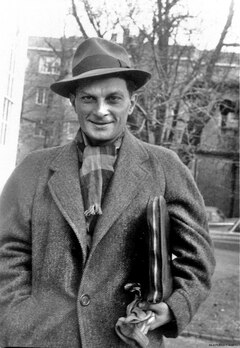Stanislaw Ulam
| Stanisław Ulam | |
|---|---|

Stanisław Ulam
|
|
| Born | Stanisław Marcin Ulam 13 April 1909 Lemberg, Austria-Hungary (now Lviv, Ukraine) |
| Died | 13 May 1984 (aged 75) Santa Fe, New Mexico |
| Citizenship | American (after 1941) |
| Nationality | Polish |
| Fields | Mathematics |
| Institutions |
Institute for Advanced Study Harvard University University of Wisconsin Los Alamos National Laboratory University of Colorado University of Florida |
| Alma mater | Lwów Polytechnic Institute |
| Doctoral advisor | Kazimierz Kuratowski |
| Doctoral students | Paul Kelly |
| Known for | Key mathematical formulations in the fields of Physics, Computer Science, and Biology Teller–Ulam design Monte Carlo method Fermi–Pasta–Ulam problem Nuclear pulse propulsion |
Stanisław Marcin Ulam (pronounced ['staɲiswaf 'mart͡ɕin 'ulam]; 13 April 1909 – 13 May 1984) was a Polish-American mathematician. He participated in America's Manhattan Project, originated the Teller–Ulam design of thermonuclear weapons, invented the Monte Carlo method of computation, and suggested nuclear pulse propulsion. In pure and applied mathematics, he proved some theorems and proposed several conjectures.
Born into a wealthy Polish Jewish family, Ulam studied mathematics at the Lwów Polytechnic Institute, where he earned his PhD in 1933 under the supervision of Kazimierz Kuratowski. In 1935, John von Neumann, whom Ulam had met in Warsaw, invited him to come to the Institute for Advanced Study in Princeton, New Jersey, for a few months. From 1936 to 1939, he spent summers in Poland and academic years at Harvard University in Cambridge, Massachusetts, where he worked to establish important results regarding ergodic theory. On 20 August 1939, he sailed for America for the last time with his 17-year-old brother Adam Ulam. He became an assistant professor at the University of Wisconsin–Madison in 1940, and a United States citizen in 1941.
...
Wikipedia
